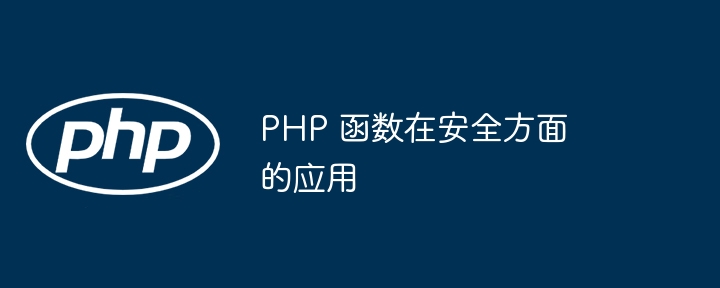Application of PHP functions in security
PHP provides a series of security functions for validating input, encrypting data, and generating security tokens. These functions help prevent malicious injection, unauthorized access, and CSRF attacks. Validating input includes validating data using filter_input() and filter_var(); encrypting data using password_hash(), hash(), and openSSL_encrypt(); and generating security tokens using bin2hex().

Application of PHP functions in security
PHP provides a series of functions to enhance the security of web applications . These functions can be used for a variety of security tasks, such as validating input, encrypting data, and generating security tokens.
Validate input
Validating user input is critical to preventing malicious injection. PHP provides several functions to help you validate data:
-
filter_input(): Validates input from the specified source using the specified filter. -
filter_var(): Use the specified filter to verify the value of the variable.
For example, to verify an email address from a POST variable:
$email = filter_input(INPUT_POST, 'email', FILTER_VALIDATE_EMAIL);
if ($email === false) {
echo '请输入有效的电子邮件地址。';
}Encrypted data
Encrypting data ensures its confidentiality, Protect against unauthorized access. The cryptographic functions available in PHP include:
password_hash(): Generates a secure hash value for storing user passwords.hash(): Use the specified algorithm to calculate the hash value of the data.openSSL_encrypt(): Use the OpenSSL library to encrypt data.
For example, to use SHA-256 hashed password:
$hash = password_hash('mypassword', PASSWORD_DEFAULT);Generate security token
Security token is used to prevent cross Site request forgery (CSRF) attack. PHP provides the bin2hex() function to generate random tokens:
$token = bin2hex(random_bytes(32));
Practical case
When registering a user, the following code uses the PHP function to Validate input, encrypt password and generate CSRF token:
<?php
// 验证电子邮件地址
$email = filter_input(INPUT_POST, 'email', FILTER_VALIDATE_EMAIL);
if ($email === false) {
echo '请输入有效的电子邮件地址。';
exit;
}
// 验证密码
$password = filter_input(INPUT_POST, 'password');
if (empty($password)) {
echo '请输入密码。';
exit;
}
$hash = password_hash($password, PASSWORD_DEFAULT);
// 生成 CSRF 令牌
$token = bin2hex(random_bytes(32));
?>The above is the detailed content of Application of PHP functions in security. For more information, please follow other related articles on the PHP Chinese website!

Hot AI Tools

Undresser.AI Undress
AI-powered app for creating realistic nude photos

AI Clothes Remover
Online AI tool for removing clothes from photos.

Undress AI Tool
Undress images for free

Clothoff.io
AI clothes remover

AI Hentai Generator
Generate AI Hentai for free.

Hot Article

Hot Tools

Notepad++7.3.1
Easy-to-use and free code editor

SublimeText3 Chinese version
Chinese version, very easy to use

Zend Studio 13.0.1
Powerful PHP integrated development environment

Dreamweaver CS6
Visual web development tools

SublimeText3 Mac version
God-level code editing software (SublimeText3)

Hot Topics
 CakePHP Project Configuration
Sep 10, 2024 pm 05:25 PM
CakePHP Project Configuration
Sep 10, 2024 pm 05:25 PM
In this chapter, we will understand the Environment Variables, General Configuration, Database Configuration and Email Configuration in CakePHP.
 PHP 8.4 Installation and Upgrade guide for Ubuntu and Debian
Dec 24, 2024 pm 04:42 PM
PHP 8.4 Installation and Upgrade guide for Ubuntu and Debian
Dec 24, 2024 pm 04:42 PM
PHP 8.4 brings several new features, security improvements, and performance improvements with healthy amounts of feature deprecations and removals. This guide explains how to install PHP 8.4 or upgrade to PHP 8.4 on Ubuntu, Debian, or their derivati
 CakePHP Date and Time
Sep 10, 2024 pm 05:27 PM
CakePHP Date and Time
Sep 10, 2024 pm 05:27 PM
To work with date and time in cakephp4, we are going to make use of the available FrozenTime class.
 CakePHP File upload
Sep 10, 2024 pm 05:27 PM
CakePHP File upload
Sep 10, 2024 pm 05:27 PM
To work on file upload we are going to use the form helper. Here, is an example for file upload.
 Discuss CakePHP
Sep 10, 2024 pm 05:28 PM
Discuss CakePHP
Sep 10, 2024 pm 05:28 PM
CakePHP is an open-source framework for PHP. It is intended to make developing, deploying and maintaining applications much easier. CakePHP is based on a MVC-like architecture that is both powerful and easy to grasp. Models, Views, and Controllers gu
 CakePHP Routing
Sep 10, 2024 pm 05:25 PM
CakePHP Routing
Sep 10, 2024 pm 05:25 PM
In this chapter, we are going to learn the following topics related to routing ?
 CakePHP Working with Database
Sep 10, 2024 pm 05:25 PM
CakePHP Working with Database
Sep 10, 2024 pm 05:25 PM
Working with database in CakePHP is very easy. We will understand the CRUD (Create, Read, Update, Delete) operations in this chapter.
 CakePHP Creating Validators
Sep 10, 2024 pm 05:26 PM
CakePHP Creating Validators
Sep 10, 2024 pm 05:26 PM
Validator can be created by adding the following two lines in the controller.






